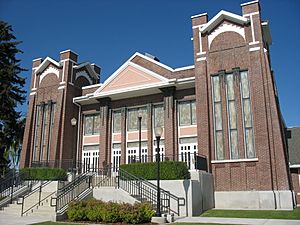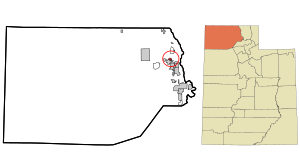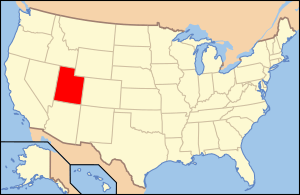Garland, Utah facts for kids
Quick facts for kids
Garland, Utah
|
|
|---|---|

The Garland Tabernacle, an early Latter-day Saint meetinghouse
|
|
| Motto(s):
"A Family Community"
|
|

Location in Box Elder County and the state of Utah
|
|

Location of Utah in the United States
|
|
| Country | |
| State | |
| County | Box Elder |
| Settled | 1890 |
| Named for | William Garland |
| Area | |
| • Total | 1.81 sq mi (4.69 km2) |
| • Land | 1.81 sq mi (4.69 km2) |
| • Water | 0.00 sq mi (0.00 km2) |
| Elevation | 4,341 ft (1,323 m) |
| Population
(2020)
|
|
| • Total | 2,589 |
| • Density | 1,430/sq mi (552.0/km2) |
| Time zone | UTC-7 (MST) |
| • Summer (DST) | UTC-6 (MDT) |
| ZIP code |
84312
|
| Area code(s) | 435 |
| FIPS code | 49-28150 |
| GNIS feature ID | 2410573 |
Garland is a city in Box Elder County, Utah, in the United States. In 2020, about 2,589 people lived there. It's known as "A Family Community."
Contents
History of Garland
Garland has an interesting past! It was first settled in 1890 and was called "Sunset." The very first person to settle here was David E. Manning.
How Garland Became a Company Town
Later, the town became a "company town." This means a big company, the Utah Sugar Company, helped build and run it. The town was renamed Garland after William Garland. He was the person who built the sugar factory, which was finished in 1903.
The company helped the town grow a lot. They gave land to the LDS Church for a meeting hall. They also built 14 homes, a hotel, and other buildings for the people living there.
Early Businesses and Growth
By 1906, Garland had important places like a general store, a bank, and a post office. There was even a local newspaper called The Garland Globe.
As the town grew, more businesses opened. By the 1920s, Garland had a flour mill and a Carnegie library. It also had its own high school, showing how much the community was developing.
Geography of Garland
Garland is located in the eastern part of Box Elder County. It sits in the beautiful Bear River Valley.
Location and Nearby Cities
The city of Tremonton is right next to Garland, to the south. If you're traveling by car, Interstate 15 passes to the west of Garland. The closest exit is about 2.5 miles (4 km) southwest of the town center.
Land Area
According to the United States Census Bureau, Garland covers a total area of about 1.81 square miles (4.69 square kilometers). All of this area is land, with no large bodies of water inside the city limits.
Population and People
Garland has seen its population grow over the years.
| Historical population | |||
|---|---|---|---|
| Census | Pop. | %± | |
| 1910 | 600 | — | |
| 1920 | 999 | 66.5% | |
| 1930 | 824 | −17.5% | |
| 1940 | 926 | 12.4% | |
| 1950 | 1,008 | 8.9% | |
| 1960 | 1,119 | 11.0% | |
| 1970 | 1,187 | 6.1% | |
| 1980 | 1,405 | 18.4% | |
| 1990 | 1,637 | 16.5% | |
| 2000 | 1,943 | 18.7% | |
| 2010 | 2,400 | 23.5% | |
| 2020 | 2,589 | 7.9% | |
| U.S. Decennial Census | |||
How People Live in Garland
In 2000, there were 1,943 people living in Garland. There were 588 households, and most of them (476) were families. Many households (51.5%) had children under 18 living with them.
The average household had about 3.30 people, and the average family had about 3.74 people. This shows that Garland is a place with many families.
Age Groups in Garland
The population of Garland is spread across different age groups. In 2000, about 39.6% of the people were under 18 years old. About 8.6% were 65 years or older. The median age in the city was 25 years old. This means half the people were younger than 25, and half were older.
Education in Garland
Garland is part of the Box Elder School District. Students in Garland attend local public schools.
High School Education
The city is home to Bear River High School. This school serves students from Garland and the surrounding areas.
Notable People from Garland
Garland has been home to some interesting people who have made a difference.
- Gail Halvorsen (1920-2022): He was a senior officer in the United States Air Force during World War 2 and the Cold War. He is famously known as the “Berlin Candy Bomber” because he dropped candy to children in Berlin during the Berlin Airlift.
- Ellwyn R. Stoddard (1927-2023): He was a respected Professor Emeritus of Sociology and Anthropology at the University of Texas at El Paso.
Images for kids
See also
 In Spanish: Garland (Utah) para niños
In Spanish: Garland (Utah) para niños


